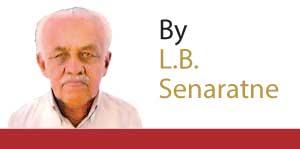11 Dec 2020 - {{hitsCtrl.values.hits}}
Keppetipola Day (November 26) was not held as in previous years, but Diyawadana Nilame Pradeep Nilanga Dela  placed a floral bouquet at the Memorial at Maha Maluwa in Kandy.
placed a floral bouquet at the Memorial at Maha Maluwa in Kandy.
Be as it may, we have to place on record the act of former President Maitripala Sirisena in naming the Freedom fighters of the 1814 Rebellion taking out the stigma placed by the British who described them as traitors. Several Heads of State and Cultural Affair Ministers had tried and promised to act in naming the freedom fighters of the Rebellion as Heroes but failed miserably because of public servants questioning how it could be done based on the Gazette published by the British Government.
|
Mahagabada Nilame Mudgalle. |
The gazette notwithstanding, the former President took the bold stand to name these Freedom fighters as Heroes and signing the document at the Magul Maduwa in the presence of the two Mahnayakes of the Malwatta and Asgiri Chapters and the Nilames of the four Devales. This action should be hailed by every citizen, especially by those in the Central, Sabaragamuwa and Uva Provinces.
There is also a controversy, whether Keppetipola or Udagabda Nilame was the real freedom fighter. This question comes from the fact that Keppetipola was in the pay of the British when he was sent to Uva Wellasa to quell the riots in Wellassa over the death of the Government Agent Wilson Sylvester and was mobbed by the people in an angry mood when he was questioned whether he was on their side or not. However, Keppetipola Maha Dissawe led the Rebellion to a certain point and gave it over the Udagabada Nilame Madugalle.
But, it should go on record that the first Independence call came from the Udagabada Nilame Madugalle, who was at the time the finest swordsman in the country and could not be matched by even the British. During the year of Sri Wickrama Rajasinghe he held the same position and after the ‘infamous Treaty’ on March 4, the British appointed him to the same rank with the Title of Dissava of Wellassa.
But, he did not last long when he was sentenced to the Fort of Jaffnapattam on December 7, 1816 for two years of hard labour, two years before the famous Rebellion, by none other than John D’Oyly and approved by Sir Robert Brownrigg. Subsequently, Madugalle was released on the Brtish Day of Prince Regent who was to become King George IV.
After he was beheaded with Maha Dissava Keppetipola, his wife was sent to Kalutara and the children to Colombo.
Though there are various schools of thought, yet there is no record to say why Keppetipola Maha Dissava left his position at the Uprising at Paraanagam and fled to Anuradhapura and later surrendered to the British.
The writer met Professor Wimalanda Dissanayake, an expert on Kandyan history while he was living at Kelaniya surrounded with the film strips he had brought down from time to time from the British Museum. He said that to him it is also a mystery why Keppetipola left the almost winning rebellion and handed it over to Madugalle. But, he could alone not carry on as the rebels on finding that Keppetipola had vanished left their ground and Madugalle was left alone.
On the other hand, Britishers were in fact “Head Hunters”. According to the records available, they were collecting
|
Signing of the document to honour the freedom fighters of 1617-1818 as Heroes by former President Maithripla Sirisena |
the skulls of Asian men. They had thought that there is a peculiarity in the heads of these warriors who fought the British and to their collection they added skulls.
In the case of Keppetipola, his friend Marshall is said to have taken the skull for study at the newly formed Phrenological Society of Edinburgh, Scotland and when it was closed the skull came to the Edinburg Museum and later to Sri Lanka and waiting inside a drawer at the Sri Lanka Museum for over five years until the agitation by Upali Keppetipola brought it to Kandy to be buried under the Memorial contained in a glass case. The skull of Keppetipola was cleaned and then salted and sent to Britain.
Recently the Veddah Chief was also presented with a skull which belonged to their tribe. Many more skulls remain in Britain at various Museums as showpieces, some have been forgotten as to from there they have been collected. Though Britishers have been skull collectors over the years, fortunately they are not now.
27 Nov 2024 1 hours ago
27 Nov 2024 3 hours ago
27 Nov 2024 4 hours ago
27 Nov 2024 4 hours ago
27 Nov 2024 4 hours ago